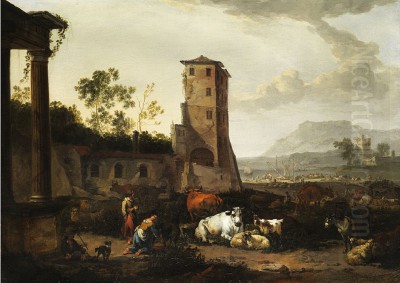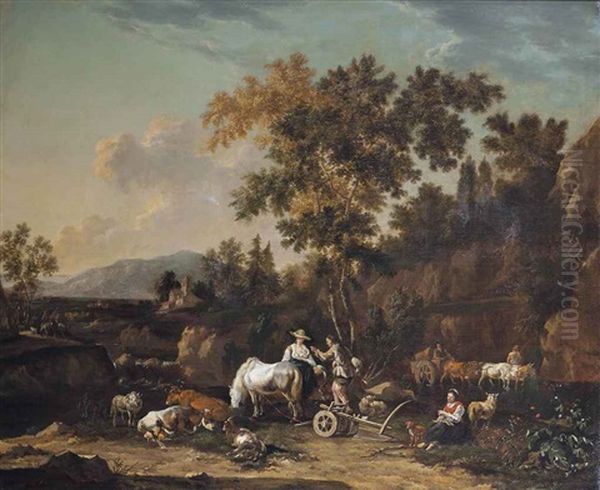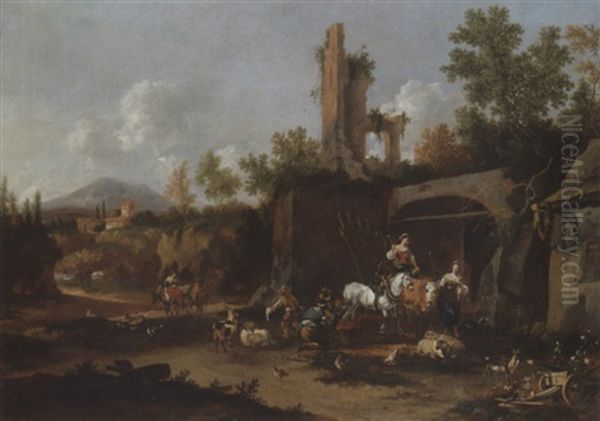Introduction: Placing Van der Bent in Time

The Dutch Golden Age, roughly spanning the 17th century, was a period of extraordinary artistic production in the Netherlands. Freed from Spanish rule and enjoying unprecedented economic prosperity, the Dutch Republic fostered a vibrant art market catering to a broad clientele, from wealthy merchants to ordinary citizens. Unlike the grand religious and mythological themes dominating art in Catholic Europe, Dutch painting excelled in genres reflecting the nation's values and interests: portraits, still lifes, domestic interiors, seascapes, and, significantly, landscapes and scenes of everyday life (genre painting). Within this rich artistic milieu worked Johannes van der Bent, a painter known primarily for his landscapes often populated with figures drawn from peasant life or depicting travelers.
While not as famous today as masters like Rembrandt or Vermeer, Van der Bent contributed to the vast output of landscape and genre scenes that characterized the era. His work reflects the prevailing tastes and artistic currents of the latter half of the 17th century, particularly the influence of popular landscape specialists. Understanding his art requires placing him within the context of his time, acknowledging both his stylistic choices and the artistic environment in which he operated. However, piecing together his life story presents challenges, as historical records can sometimes be sparse or even contradictory for less prominent artists of the period.
Biographical Notes and Chronological Uncertainty
Establishing the precise biographical details for Johannes van der Bent encounters some ambiguity, a common issue for artists who did not achieve the highest tier of fame in their own time or shortly thereafter. The widely accepted consensus among art historians places his period of activity firmly within the Dutch Golden Age, specifically between approximately 1650 and his death around 1690. He is believed to have been born and primarily active in Amsterdam, the bustling heart of the Dutch art world.

However, it is worth noting that some disparate records, potentially referring to a different individual with the same name, have occasionally caused confusion. For instance, information suggesting a Johannes van der Bent born around 1720 in Kings County, New York, and dying in New York City in 1771, appears in certain genealogical or colonial records. This timeline is inconsistent with the known artistic production, style, and documented influences associated with the painter Johannes van der Bent. The style of painting attributed to him belongs unequivocally to the 17th-century Dutch school, not the 18th-century colonial Americas. Therefore, the art historical narrative focuses on the 17th-century Amsterdam artist who passed away near the end of that century.
Artistic Training and Influences: Following the Masters
Johannes van der Bent's artistic style indicates a strong connection to some of the leading painters of his time, suggesting a period of apprenticeship or close study. Art historians generally agree that he was a pupil or, at the very least, a dedicated follower of Philips Wouwerman (1619–1668). Wouwerman was an immensely popular and prolific Haarlem-based painter celebrated for his landscapes featuring horses, cavalry skirmishes, hunting parties, and travelers resting at inns. His elegant compositions, skillful rendering of horses in motion, and detailed figures set a standard that many artists sought to emulate.
Van der Bent's work often echoes Wouwerman's thematic concerns, frequently including horses, travelers, and wayside inns within his landscape settings. The careful arrangement of figures and animals within the natural environment points towards Wouwerman's model. Furthermore, Van der Bent seems to have absorbed compositional strategies and motifs characteristic of his presumed master.
Another significant influence often cited is Nicolaes Berchem (1620–1683). Berchem was a leading figure among the Dutch Italianate painters – artists who either traveled to Italy or adopted the warm light, picturesque ruins, and idealized pastoral atmosphere associated with the Italian countryside. Berchem was highly versatile, painting landscapes, mythological scenes, allegories, and animals. His Italianate landscapes, bathed in a golden Mediterranean light and populated with shepherds, peasants, and livestock, were particularly sought after. Van der Bent's occasional use of warmer light palettes and certain types of pastoral staffage suggests he was also looking closely at Berchem's successful formula.
Style and Subject Matter: Landscapes with Life
Johannes van der Bent specialized primarily in landscape painting, often integrating strong genre elements. His canvases typically depict rural scenes, woodland paths, rolling hills, or views featuring rustic buildings like cottages or inns. These settings serve as backdrops for human and animal activity, which is central to his compositions. Unlike the pure, often uninhabited, landscapes of artists like Jacob van Ruisdael, Van der Bent's works are usually animated by figures.

Common subjects include peasants resting or working, travelers halting at an inn, herdsmen with their livestock, or riders on horseback traversing the countryside. His interest lay in capturing these small narratives within a broader natural context. The figures, while not usually individualized portraits, are rendered with sufficient detail to convey their activities and social station. Animals, particularly horses and cattle, are also frequent components, handled with a competence likely honed by studying Wouwerman.
Stylistically, his work aligns with the trends of the latter half of the 17th century. His brushwork is generally detailed and descriptive, aiming for a convincing representation of textures and forms, though perhaps not achieving the exquisite refinement of Wouwerman or the atmospheric subtlety of the greatest landscape masters. His use of light varies; some works employ the cooler, more silvery tones typical of native Dutch landscapes, while others adopt the warmer, golden hues associated with the Italianate style, reflecting Berchem's influence. Compositionally, he often used diagonals, such as roads or streams, to lead the viewer's eye into the scene, a common device in Dutch landscape painting.
The Dutch Landscape Tradition: A National Passion
Landscape painting blossomed during the Dutch Golden Age, becoming one of the most characteristic and popular genres. Early pioneers like Esaias van de Velde and Jan van Goyen moved away from the artificial, panoramic "world landscapes" of the 16th century towards more naturalistic depictions of the Dutch countryside. The "tonal phase" of the 1620s-1640s, led by Van Goyen and Salomon van Ruysdael, emphasized atmospheric effects through a limited palette of browns, grays, and greens.
Later in the century, artists like Jacob van Ruisdael and Meindert Hobbema introduced a more "classical" or monumental approach, often featuring dramatic cloudscapes, majestic trees, and a greater sense of nature's power and grandeur. Ruisdael, in particular, is celebrated for his evocative and often melancholic views of forests, waterfalls, and castles. Hobbema, his pupil, is known for his charming depictions of watermills and wooded lanes, such as the famous Avenue at Middelharnis.
Alongside these depictions of the native Dutch scenery, another significant trend emerged: the Italianate landscape. Artists drawn to the classical past and the sunny climes of Italy created idealized visions of the Roman Campagna, often incorporating ancient ruins, picturesque shepherds, and a warm, golden light quite different from the typically overcast skies of Holland. Johannes van der Bent operated within this diverse landscape tradition, blending elements of native Dutch scenery with the figure-centric approach of Wouwerman and the occasional Italianate warmth derived from Berchem. He represents the numerous competent painters who catered to the market's demand for pleasant, populated landscapes.
Italianate Painters and Their Influence
The allure of Italy held a powerful grip on the imagination of many Northern European artists. While some, like Jan Both and Jan Asselijn, spent considerable time south of the Alps, others, possibly including Van der Bent, absorbed the Italianate style second-hand through the works of returning artists or influential figures like Nicolaes Berchem who successfully adapted the style in Amsterdam. Karel Dujardin was another prominent Italianate painter, known for his charming small-scale landscapes with peasants and animals bathed in clear, sunny light.
The Italianate style offered an alternative to the sometimes stark realism of native Dutch landscapes. It provided opportunities for more picturesque compositions, idealized figures, and a generally brighter, more optimistic mood. The inclusion of classical ruins added a layer of historical resonance and romantic appeal. Van der Bent's work sometimes partakes in this tradition, seen in the warmer light and the types of figures he includes, such as resting shepherds or travelers who seem slightly removed from the specific realities of Dutch peasant life. This blending of influences allowed artists like Van der Bent to appeal to patrons who appreciated both local scenery and the fashionable exoticism of the South.
Genre Elements: Scenes of Daily Life Outdoors
The Dutch had a particular fondness for genre painting – scenes depicting everyday life. Masters like Jan Steen captured lively, often chaotic, domestic scenes and tavern interiors with humor and moralizing undertones. Adriaen van Ostade and his brother Isack van Ostade specialized in portraying peasant life, sometimes in dimly lit interiors, other times in outdoor settings like village fairs or resting by the roadside. Paulus Potter achieved fame for his remarkably lifelike paintings of animals, especially cattle, often set within expansive Dutch pastures.
Johannes van der Bent participated in this trend by making genre elements a key feature of his landscapes. His focus was less on interior scenes and more on the activities of people outdoors. The "halt at the inn," a theme perfected by Wouwerman, became a recurring motif for Van der Bent. These scenes allowed for the depiction of various social types – travelers, soldiers, innkeepers, peasants – interacting within a specific setting. Similarly, his depictions of peasants working or resting in the fields connect his work to the broader interest in rural life found in Dutch art. Adriaen van de Velde was another contemporary who excelled at integrating exquisitely painted figures and animals into landscape settings, often with an Italianate flavor. Van der Bent's work, while perhaps less refined, shares this interest in animating the landscape with relatable human activity.
Representative Works: The 'Landscape with Peasants' Theme
Identifying specific, named masterpieces by Johannes van der Bent can be challenging, as many works by less famous Golden Age painters lack unique titles or extensive provenance. However, descriptive titles like Landscape with Peasants, Travelers Halting at an Inn, or Wooded Landscape with Riders are commonly associated with his oeuvre and accurately reflect his typical subject matter. A work titled Landscape with Peasants, generally dated between 1670 and 1690, is often cited as representative of his style. Such a painting would likely feature a rustic setting, perhaps with rolling hills or trees, populated by several peasant figures engaged in simple activities – resting, conversing, or tending to livestock. The influence of Wouwerman might be visible in the inclusion of horses, while a warmer light could suggest Berchem's impact.
It is important to exercise caution with generic titles like Landscape with Peasants, as this theme was extremely common. Indeed, the same title is associated with works by artists from different periods and regions, such as the German Rococo painter Johann Conrad Seekatz (whose version dates to 1765) or even the earlier Flemish Renaissance artist Abel Grimmer. This highlights the potential for confusion arising from non-specific titles or historical misattributions. Nevertheless, the type of scene depicted in a "Landscape with Peasants" – a harmonious blend of nature and everyday human presence – is central to Johannes van der Bent's contribution to Dutch art. His paintings consistently explore this relationship between people and their environment.
Contemporaries and the Amsterdam Art Scene
Working primarily in Amsterdam during the latter half of the 17th century, Johannes van der Bent would have been immersed in one of the most dynamic art centers in the world. Although direct records of his interactions with other artists are scarce, he would undoubtedly have been aware of the major figures and trends. While Rembrandt van Rijn (d. 1669) represented an older generation, his powerful influence lingered. The city hosted numerous successful painters specializing in various genres.
Besides his likely mentors Wouwerman (based in Haarlem but whose works were widely known and collected in Amsterdam) and Berchem (active in Amsterdam), Van der Bent's contemporaries included landscape painters like Jacob van Ruisdael (who moved to Amsterdam) and Meindert Hobbema. Genre painters like Jan Steen (who worked in several cities, including Amsterdam for a time) and Gabriel Metsu were creating popular scenes of domestic life. The fijnschilders ("fine painters") like Gerard Dou (in Leiden, but influential) set standards for meticulous detail. Van der Bent's chosen specialty, the populated landscape, placed him in dialogue with artists like Berchem, Wouwerman, Adriaen van de Velde, and Karel Dujardin, all catering to a strong market demand for such scenes.
Attribution Challenges and Legacy
Like many Dutch Golden Age painters who worked in the style of more famous masters, Johannes van der Bent faces challenges regarding attribution. His close adherence to the styles of Wouwerman and Berchem means that some of his works may have been historically misattributed to them, or vice versa. Distinguishing the hand of the master from that of a skilled pupil or follower often requires careful connoisseurship. Furthermore, the sheer volume of art produced during the period, and the common practice of artists specializing in similar subjects, complicates definitive attributions, especially for unsigned works.
Despite these challenges, a body of work is recognized as belonging to Johannes van der Bent, found in various museum collections across Europe. While he may not have been an innovator who drastically changed the course of Dutch art, he was a capable and productive painter who skillfully synthesized the popular styles of his time. He catered effectively to the tastes of the Dutch art-buying public, producing attractive landscapes animated with the scenes of everyday life that were so characteristic of the Golden Age. His legacy lies in his contribution to this rich and varied artistic tradition, representing the many talented artists who formed the backbone of the Dutch art market beyond the handful of universally recognized names.
Conclusion: A Competent Contributor to the Golden Age
Johannes van der Bent emerges from the historical and art historical record as a competent Dutch painter active in the second half of the 17th century, primarily associated with Amsterdam. Specializing in landscapes populated with genre figures – peasants, travelers, horses, and livestock – his work clearly shows the strong influence of Philips Wouwerman and Nicolaes Berchem. He adeptly combined elements of native Dutch landscape traditions with the popular Italianate style, creating pleasant and engaging scenes that appealed to contemporary tastes.
While biographical details remain somewhat uncertain, and his work is sometimes subject to attribution debates, Van der Bent holds a place as a representative figure of the numerous artists who sustained the remarkable breadth and depth of the Dutch Golden Age art market. His paintings, typically titled descriptively like Landscape with Peasants or Travelers Halting at an Inn, offer valuable insights into the popular themes and stylistic currents of his time. He remains a figure worthy of study for understanding the full spectrum of landscape and genre painting during this extraordinary period in art history.